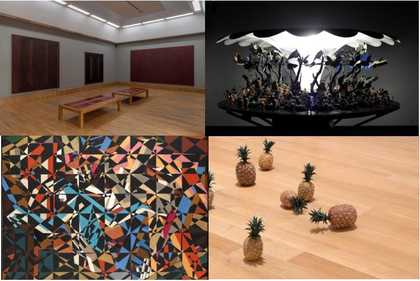
Image: Top row: Installation view of Mark Rothko: The Seagram Murals at Tate Britain. Courtesy Tate photography/ Mat Collishaw The Garden of Unearthly Delights 2009 (c) Mat Collishaw. Bottom Row: David Bomberg In The Hold 1913-14. (c) Tate / Installation view of Edward Allington and Pablo Bronstein at Tate Britain. Courtesy Tate photography
Several new displays have opened at Tate Britain as part of the museum’s three collection routes, all of which are available for visitors to book online for free. Rothko and Turner is a new route opening to celebrate 50 years since Mark Rothko first gave Tate his iconic Seagram Murals to join the fearless and atmospheric paintings he so admired by JMW Turner. The route through British Art 1540-1920 now includes a new room devoted to weird and wonderful artworks about fairies from the past 200 years including Mat Collishaw’s magical three-dimensional animation Garden of Unearthly Delights 2009, as well as displays focusing on Gwen John, Stanley Spencer and the Vorticists. British Art 1930-Now has also been expanded with a new display about Kim Lim, including works which have never been seen before, as well as a room of ground-breaking sculptures from the 1980s.
All three routes also include access to Tate Archive’s 50th anniversary display, telling stories of new beginnings, historic moments and personal histories. From sketchbooks and drawings to unpublished photographs and letters, visitors can discover a host of treasures from the world’s largest archive of British art, including Vanessa Bell, John Constable, Lubaina Himid, Derek Jarman, L.S. Lowry, Ronald Moody, Marlow Moss, Donald Rodney and Jo Spence amongst many others.
TURNER AND ROTHKO
Rothko’s Seagram Murals 1958-9 were originally commissioned as a series of mural-scaled paintings for the fashionable Four Seasons restaurant in New York’s Seagram building. The artist eventually decided to give the paintings to Tate instead, in the hope that they would be seen near the Turner Bequest, Tate’s unparalleled collection of work by British landscape painter JMW Turner. 50 years later, these two artists can now be seen together as part of Tate Britain’s new Rothko and Turner collection route, reflecting the ongoing relationship between British historic art and international modern art. The route begins with the powerful Seagram Mural paintings, before showcasing highlights from throughout JMW Turner’s career.
This display also coincides with a landmark exhibition opening at Tate Britain later this month – Turner’s Modern World – which will reveal how Britain’s greatest landscape painter captured technology’s impact on the natural world and the dizzying effects of modernisation on society.
BRITISH ART 1540 - 1930
This route through British art history from the Tudors to the First World War has been expanded with five new displays. One room focuses on the fascinating tradition of ‘fairy painting’ in Britain, a craze sparked in the late 18th century by Romanticism’s fascination with nature and the imagination. This display looks at the way artists used images of fairies to explore tensions between the natural and the supernatural, beginning with William Blake and Richard Dadd and culminating in Mat Collishaw’s Garden of Unearthly Delights 2009. Other contemporary responses to historic art can also be seen in a nearby display of work by Pablo Bronstein and his art school tutor Edward Allington. Both artists in very different ways use the formal language of architecture to engage with history, exploring the clash of traditions and philosophies between classical forms and contemporary realities.
Three other new rooms focus on particular artists or movements. One brings together 13 works by Gwen John (1876-1939), best known for her subtle portraits of women – apparently serene paintings which in fact visualise her intense artistic engagement with the sitters and the wider art world. Another room includes highlights from Tate’s extensive collection of Stanley Spencer’s (1891-1959) work, from early self-portraits to later compositions imagining his home village as a location for religious miracles. The Vorticists, a dynamic art movement that emerged in 1914 as Europe descended into war, is also the subject of a new display of works by Wyndham Lewis, William Roberts, Edward Wadsworth, Jessica Dismorr, Helen Saunders, Jacob Epstein and Henri Gaudier-Brzeska.
BRITISH ART 1930- NOW
Two new rooms join Tate Britain’s route through modern and contemporary British art. The first explores the relationship between sculpture and printmaking in Kim Lim’s (1936-97) early work. Born in Singapore, Lim moved to England in 1954 to study art. She explored forms, textures and ideas through printing that she continued to develop in the slower process of wood carving. Likewise, ideas that first appeared in her sculpture informed new explorations in her printmaking. The display also includes a selection of never before seen works such as Split Red 1960 and Sphinx 1960.
Another room features a mixture of sculptures and drawings from the 1980s by Shelagh Cluett, Richard Deacon, Anish Kapoor and Alison Wilding, artists who emerged at a moment when methods for making sculpture were being radically rethought. Their works share a focus on the physical construction of art, highlighting materiality, mass and volume in their work.
All routes are open today and visitors can book for free at https://protect-eu.mimecast.com/s/_o39Cko4YU58Ps22rfz?domain=tate.org.uk.
